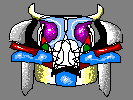View current page
...more recent posts
I've recently read William Gibson's new novel Pattern Recognition, reread his "Virtual Light trilogy" (Virtual Light, Idoru, and All Tomorrow's Parties), and have been following his weblog, and am now jotting down a few thoughts. First, Gibson has really mellowed over the years. As he himself says, he no longer does "deep fried anomie" or even cyberpunk. Pattern Recognition is his first attempt at a mainstream novel with tech (as opposed to sci fi) elements. I have to say it's less satisfying because it limits his imagination. His gift for extrapolating/exaggerating current trends into pungent satire hasn't disappeared but it's severely circumscribed. Also, it's a weird book because the writing of it clearly straddled 9/11. The "hunt for the perfect pair of sneakers" he started at the go-go turn of the millennium acquired a melancholy 9/11 subplot which skews (and actually comes to dominate) the tone. I realize that many of us went through a similar thought process but Gibson's unabashed consumerism (reverent descriptions of clothes and gear) makes the transition to a meaner, leaner consciousness even bumpier.
One thing PR shares with all the books that preceded it is a weak plot. The Virtual Light novels each relied on what Alfred Hitchcock calls a "McGuffin"--some object that drives the story but turns out not to be terribly important (respectively virtual sunglasses, a nanotech generator, and a kind of fax teleporter, the last being the most significant of the three). I won't spoil PR but the thing the main characters are focused on feels like another McGuffin. And once again an artist is a supernatural hero figure--I sometimes think WG was born to be an art critic [update: more on this here], even though I don't entirely trust his eye (Cornell? Noritoshi Hirakawa?). What Gibson does best is make cutting social observations in gemlike prose, e.g., his travelogue through a one-step-removed Japan in Idoru, his thoughts on reality TV (Slitscan, Cops in Trouble), and in the new book, bleeding-edge trendspotting or "cool hunting." Which brings me to my main point: why do these things have to be in a novel?
I was somewhat let down when I found out his weblog was a kind of promotional stunt, timed to coincide with the PR book tour and then to end. I actually thought for a moment that he might be an old media guy that wrote about new media and one day started living it. At this stage of his career a weblog seemed like a better vehicle for his dry observations than his novels, which are becoming lackluster, as novels. It seems silly to be killing a bunch of trees and providing grist for the book-publishing hype cycle when he could be communicating directly, and semi-interactively, with his core readership. I briefly, naively imagined him living on the royalties from his rather lucrative back-catalogue and just blogging. Oh well, not everyone is made for the potlatch economy. I'm not sure I am either, so I'm sorry for projecting. To be honest, I worry about being sucked wholly into the blogosphere, like Colin Laney disappearing through a "nodal point" into pure data, and was hoping for a prominent guinea pig. *pities self*
Postscript: After I wrote this I visited Gibson's blog to get its hyperlink and found this stuffy piece on "writing vs blogging." I guess as he prepares to start work on that next book after being a pretend-blogger for a few months (he says the two activities are mutually exclusive), he's decided to go out with a bitchslap, by declaring bookwriting more important than blogwriting. As for the supposed ease of weblog writing, I can only say speak for yourself.
[Update, July 2005: Gosh, this post is harsh. Gibson did restart his blog a year after the "stunt" and kept it going for a few months, but it has trailed off again. With two years hindsight I have only to add, not everyone has the need or personality for regular blogging. I'm not sure I always will. Blogging is right for me because I like to post sound and pictures (as opposed to say, a novel, where I would constantly be having to suppress and channel other senses through a linear stream of words), but that's me. Different strokes and all that...]


Slate has a rather tedious essay up at the moment explaining The Matrix's appeal to geeks. (Nerd becomes hero; it's like a computer game; other obvious points.) A more pertinent question is why it did so well with non-geeks. I saw the movie in a packed Times Square theatre and can attest that the kung fu-cheering audience came from all walks of life--not just Silicon Alley. Salon critic Andrew O'Hehir had an observation three years ago that now seems almost nostalgic:
The Matrix was the first movie of '99 to tap into the deepening unease surrounding the info-consumption economy. Its vision of the human race as isolated prisoners being forcefed an electronic false reality is, after all, pretty much true.I say almost nostalgic because while the context has changed from Clinton bubble to Bush endless-terror-war, the "electronic false reality" still remains in place. Even though I saw the World Trade Center fall with my own eyes, the image became intermixed almost immediately with the mediated version on TV, which had camera angles and freeze frame capability and running commentary unavailable to my bare senses. As Slovenian theorist Slavoj Zizek points out (thanks, Bruno), the twin towers' destruction was exactly the type of Hollywood blockbuster explosion America had been feeding itself as entertainment in the years preceding 9/11 (think Independence Day). In his essay written a few days after the WTC-toppling, Zizek somewhat touchingly wondered if the event would open our country's eyes to its own filtered, Truman Show reality. As if! From the slime tanks where we serve as human batteries, we've now seen two Matrix-like wars won with sheer technology. I didn't witness it, but read many media accounts of Pres. Bush's photo-op jet landing on an aircraft carrier after he "whipped Saddam's ass." The newscasters were gushing about how good he looked in a flight jacket. Maybe for the next war he can wear a long black coat.
Saturday I attended a rare screening of the 1910 Edison Frankenstein, at the Loew's Jersey Theatre, a semi-restored 1929 film palace (and I do mean palace--it's huge) in Jersey City. Only one print of the film exists, owned by collector Alois Dettlaff, who spoke at the event; he'd never before allowed it to be shown outside his home state of Wisconsin. It's a strange, very short (14 min.) interpretation, which differs radically from the Shelley and Whale versions. Dr. Frankenstein doesn't cobble the Monster together from body parts but grows him in a kind of giant cannibal's pot, watching the process through a peephole. The stop-motion birth sequence resembles decay in reverse: the creature grows from the inside out--bones first, then flesh, then skin and hair (and rags for clothes).* The finished Monster looks like a cross between the Elephant Man and a Kabuki actor, wearing elf shoes and leggings.
Other recent Big Screen adventures: City of God is one of the most violent films I've ever seen, made even more disturbing because an awful lot of the people firing big guns and being killed by them are children. Think the bleak urban quasi-documentary style of Bunuel's Los Olvidados (set in a notorious slum of Rio de Janeiro rather than Mexico) combined with blaxploitation-cum-Tarantino cinematic highjinks. This is a gripping and, I'm sorry to have to say, entertaining sociohorror/action/coming-of-age film (the director's mordant humor helps the audience process all the tragedy). David Perry gives a good rundown of the plot here (thanks to Bruno for introducing me to this writer).
Also bleak but completely absorbing is Lilya 4-Ever, about a teenage girl in post-Soviet Russia dragged into prostitution by a whirlwind of negative forces: parental abandonment, lack of a social safety net, bottom feeders on the make. It reminds me a bit of Von Trier's Breaking the Waves in that the girl is very sympathetic and appealing and what she goes through is horrendous. The "bathtub scene" is particularly haunting in its casual brutality. Again, the director finds exactly the right tone to make a moral film that's not preachy or (too) exploitative.
Finally, please go see Phone Booth instead of Identity, while the former's still in theatres, and put some money in Larry Cohen's pocket. He's one of our smartest filmmakers and even though this is only from his script, he's clearly the auteur (fortunately paired with the directing talents of the Falling Down/Car Wash Joel Schumacher, as opposed to the Batman & Robin Joel Schumacher). It's an intricate, high concept plot: man pinned in phone booth for entire movie, taunted over the receiver by omniscient sniper, vaguely recalling a Joseph Stefano-penned Outer Limits episode from the 1960s called Fun and Games, in which a mellifluous-voiced ET probes the sordid, petty inner lives of a couple of very ordinary Americans, as they struggle for survival in an elaborately contrived game. ("Mwa-ha-ha-ha! Why did you run away from him, Miss Hanley? So that he can eat all of the food? Or so he can do all of the fighting? Your heart is a bottomless box of virtuous motives, isn't it?"--that's Stefano, not Cohen, but I love those lines.) Good discussion of Phone Booth by Armond White here; not sure what he's saying exactly about Cohen vis a vis the classic films of the '70s, though.
* The "fleshing out" sequence is a staple of current horror films (Hellraiser and Hollow Man come immediately to mind) but the 1910 version is closer to the low budget scares of Eraserhead or the Lovecraftian glop in Quatermass 2. The stop-motion-plus-decay also made me think of the Brothers Quay.
Wild Berry Crisp, 2003
Last night I went to hear Discoteca Flaming Star at the BQE Lounge in Brooklyn. It's a duo from Berlin that plays with musicians assembled on the spot in whatever area the pair happens to be touring. Practice sessions can be as brief as an afternoon, so we're talking some real Portsmouth Sinfonia potential here. I was invited by artist Tom Früchtl, visiting from Munich, who has also played guitar in German punk bands over the years. Früchtl was part of the backup ensemble, which included another guitar player and a drummer playing a laptop keypad. The music was nothing as chaotic as I expected--a lot of it was quite soulful and melodic. Very strange mix of krautrock, electro, AC/AC, Abba, and karaoke, with anti-charismatic singer Wolfgang Mayer dressed like a goth chick in arm stockings and black crocheted cap (his face has some of the cragginess of Klaus Kinski's, even with 2-inch false eyelashes). His bass-playing partner Cristina Gómez Barrio, a sultry brunette from Spain, also did the gender-confusion thing, with an emphatic song about the size and potency of her balls. Highlights included a duet in Spanish, a rad cover of the Stooges' "We Will Fall," and a plaintive riff on "Sexual Healing."
Before the concert, Früchtl introduced me to Nathan Abbott, who makes electro tracks under the name Freezie Freekie. Later I checked out a couple of samples on the Satamile label (a quite interesting New York imprint specializing in electro since the mid-'90s) and liked them a lot, particularly the dreamy filter-swirl of "Slow Decay." In the middle of the concert Abbott suddenly pointed out that Discoteca Flaming Star reminded him of Tuxedomoon (an art punk band from San Francisco that moved to Belgium around 1980)--the electronic percussion, the noize, the art vibe was certainly all there; the main difference being guitars (Tuxedomoon was bass, beatbox, violin, sax, and keyboards). Anyway, interesting comment; it made me listen to the music in a different way, imagining how it might have been to hear TM doing the punk cabaret of their early years (documented on the 1987 record Pinheads on the Move).

20X6 vs. 1936 The Unauthorized Script
SCENE: A futuristic landscape, with green manicured park and rounded modern buildings in the background. STINKOMAN, a masked, blue-haired Japanese animation character who looks suspiciously like STRONG BAD, is training. He boxes the air and makes martial arts yells. Videogame music (NES' Rad Racer) plays underneath.
HOMESTAR RUNNER enters from right. This is "old timey" Homestar, a cartoon figure straight out of a black and white 1930s one-reeler, complete with celluloid scratches and hair caught in the projector. Like a hologram, he doesn't appear to inhabit the same spacetime continuum as STINKOMAN, yet the characters interact. He is kicking a crumpled can, which bumps STINKOMAN's foot.
STINKOMAN: Wha-? Who are you? (NOTE: All STINKOMAN's lines are delivered in an exaggerated, shouting voice, as in a bad English anime translation.)
HOMESTAR (with nasal, "country" accent) : I'm-a Homestar Runner.
STINKOMAN: That name is dumb. It sounds like it's so dumb.
[SLIGHT PAUSE, as if STINKOMAN'S words are delayed in tachyon transfer between dimensions.]
HOMESTAR (in CLOSEUP): Well, what's your moniker?
STINKOMAN: I go by Stinkoman. That's the name of talented fighter (sic) if ever there was one!
HOMESTAR: Okay. If you say so. Would you care for some dry meal? (Bag labeled "DRY MEAL" appears out of nowhere and hits ground with a loud wheeze)
STINKOMAN: No way. I'm training for fighting. Or maybe a challenge. So what's that thing you're kicking around?
HOMESTAR: Oh, that's just an old can of water soup. (CLOSEUP of HOMESTAR looking sad) I kick it around ever since my dog washed away in the storm of '28.
STINKOMAN: You seem like you might not be from around here. Do you have any special powers?
HOMESTAR: I can play a mean washboard. (Washboard materializes. As HOMESTAR scratches it rhythmically, STINKOMAN begins bobbing up and down involuntarily.)
STINKOMAN: What is that? What is that? Some kind of robot?
HOMESTAR (another slight pause): What's a robut?
STINKOMAN: You don't know what a robot is? (Pointing) HA HA HA HA! You are so dumb. (CLOSEUP of STINKOMAN laughing with cartoon steampuffs coming out from his head) HA HA HA HA! Dumb!
HOMESTAR (while STINKOMAN is laughing): Oh, go soak your fat head.
STINKOMAN: Are you asking me for a cha-a-a-LLENGE? (Begins powering up, Dragonball Z style, a halo of energy growing around his body)
HOMESTAR (while STINKOMAN is powering up): Yes sir. Yes sir, I am.
[STINKOMAN's energy aura reaches full power and with a cry of "Double Deuce!" he leaps into the sky. As he begins plummeting downward, HOMESTAR aims a peashooter at him and fires with an audible "ptui."
LOW ANGLE SHOT looking up at the rapidly descending STINKOMAN. HOMESTAR's spitball hits STINKOMAN's eye just as he is about to land on HOMESTAR.]
STINKOMAN (back on ground, howling with pain): My eye! It's like my eye! It hurts so bad!
HOMESTAR (as STINKOMAN jumps in pain): Well, folks, you know what that means. Now I'll do a dance.
[HOMESTAR launches into a comical dance, splaying his feet and twisting his head to inane electric piano music. STINKOMAN stops wailing when he sees what HOMESTAR is doing.]
STINKOMAN (pointing at HOMESTAR): HA HA HA. That dance cracks me up. You gotta teach me.
HOMESTAR: Just kind of...shimmy and shake.
STINKOMAN (imitating HOMESTAR's dance): Yeah! Now I've got it.
[The two dance jerkily, several feet apart, calling out each other's dates of origin.]
HOMESTAR: 20X6 (pronounced "Twenty Exty-six").
STINKOMAN: 1936!
HOMESTAR: 20X6.
STINKOMAN: 1936!
HOMESTAR: 20X6.
STINKOMAN: 1936...
[The call-and-response continues as picture FADES TO BLACK]
